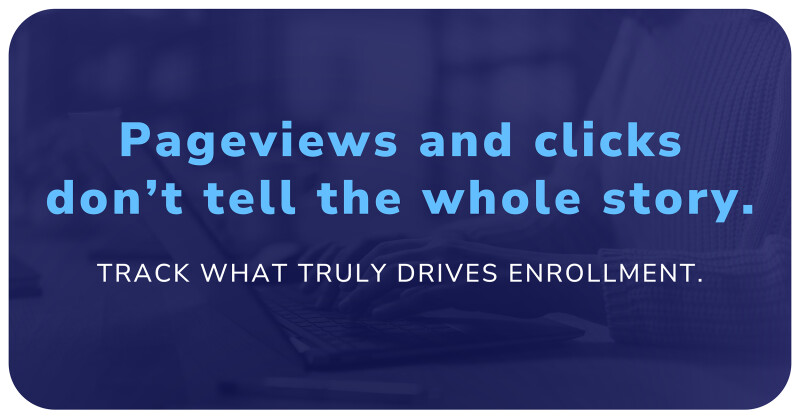The rise of generative AI is transforming how students search for, discover, and evaluate academic programs. It’s also forcing marketing teams to rethink performance measurement from the ground up.
In a world where AI tools summarize content, answer questions, and guide decisions—often before a student visits your website—traditional metrics like page views and click-through rates tell only part of the story.
As you adapt your strategy, here are six critical (and sometimes tough) questions that you—and your leadership team—should be asking about performance measurement in the AI era.
1. “How do we measure visibility if students never click?”
Welcome to the era of zero-click impressions. Students are increasingly getting their questions answered directly in Google AI Overviews, featured snippets, or tools like ChatGPT—without ever clicking a link.
You can’t rely on traffic alone to prove value. Instead, look at:
- Search Console impression data
- Featured snippet presence
- AI-generated summaries of your programs
- And most importantly, what happens down-funnel (more on that below)
Even if students don’t click, your content is influencing their decisions—and that matters.
2. “How do we prove ROI to leadership without traffic data?”
When traffic trends down, it’s easy to panic. But decreased site visits don’t necessarily mean decreased interest. Instead, focus on influence over visibility.
Show leadership how you're:
- Improving conversion efficiency (fewer visits, better outcomes)
- Increasing AI placements for branded and category terms
- Delivering high-quality inquiries and applicants, even if the path is less direct
AI is changing the nature of the funnel, not eliminating it.
3. “Can we trust AI summaries of our programs?”
It’s a fair concern. You don’t control what AI says—but you can influence it.
Invest in:
- Semantic optimization (structured data, clean HTML, clear metadata)
- Content depth and topical authority
- Monitoring branded queries to track how your programs appear in AI tools
It’s not about perfect control—it’s about smart positioning and ongoing refinement.
4. “If we focus on late-stage metrics like applications and enrollments, will we miss important early signals?”
It’s a fair concern—and the short answer is: we still track early signals, but we don’t rely on them alone.
In an AI-disrupted landscape, top-of-funnel activity is harder to measure. Students may interact with your content in an AI-generated summary or voice assistant without ever clicking through to your site. That means traditional early-stage indicators—like pageviews or CTR—don’t always reflect true interest or intent.
That’s why we emphasize down-funnel metrics like applications and enrollments. These are the clearest indicators of what’s actually driving student outcomes. By tying inquiries and conversions back to specific campaigns and channels, we can:
- Understand what’s working in a fragmented discovery environment
- Catch gaps where visibility isn’t translating into action
- Make smarter optimization decisions based on results, not just reach
So no—we’re not ignoring early signals. But we are prioritizing the data that ties directly to enrollment goals. Because in this new era, the most reliable insight often starts at the bottom of the funnel.
5. “Can we really attribute enrollments back to AI-driven interactions?”
It’s harder—but not impossible.
Use a blend of:
- CRM data
- UTM tracking
- Channel-level performance analysis
Even if you can’t attribute a specific student to a ChatGPT answer, you can analyze broader patterns—like which campaigns or content types lead to higher-quality conversions.
6. “How do we define a high-quality student inquiry now?”
Not all inquiries are created equal. In the AI age, quality means:
- High intent
- Strong program fit
- Application follow-through
- Likelihood to enroll
Evaluate inquiries not just by volume, but by:
- Engagement signals (e.g. multiple touchpoints, time on task)
- Source-to-yield performance
- Post-lead behavior
When you optimize for quality, not quantity, your funnel becomes more resilient to AI disruption.
Final Thought: The Metrics That Matter Now
The top of the funnel is shifting—from click-dependent to AI-influenced. Success in this new environment requires evolving your KPIs to reflect:
- Where decisions are really being made
- How your content performs within AI ecosystems
- Which efforts drive actual enrollment outcomes
Marketing leaders who adapt their measurement mindset will not only survive this shift—they’ll lead it.

